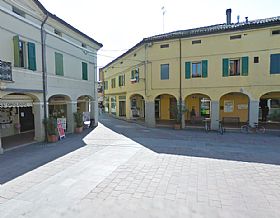Ferrara

Ferrara is a surprise - a beautiful art city filled with incredible architecture and interesting streets, yet under-visited by tourists. Despite its UNESCO World Heritage Site designation, the city sits largely unknown and off the main path for the majority of foreign visitors - which is both a shame, and lends to its charm.
The ancient moat and walls protected the city, and are still intact. You can enjoy a bike ride or walk around the walls for a nine-kilometer work-out accompanied by antique charm! The city has a unique urban plan; the mighty Este family that ruled it planned and built Ferrara over the three centuries of their reign at the turn of the Middle Ages to the Renaissance, giving it a beautiful architectural blueprint. You'll find lovely lanes, turreted palaces, narrow streets, grand buildings and arcades. The castle was constructed in both styles, with the medieval section on one side and the Renaissance addition on the other.
The university where Copernicus studied is here; its 12,000 students make the city a lively place. Via delle Volte is a stone-vaulted street, while the Loggia dei Mercanti was built abutting the cathedral with a colonnade and the city's old statutes engraved on marble stones. The cathedral looks like a wedding cake with its sculpted marble; don't miss the museum, called Museo del Duomo, with priceless masterpieces to gaze upon. Across the street is one of Ferrara's many beloved wine bars.
The palaces are noteworthy and noble. The most famous, Palazzo dei Diamante, has a facade of marble "diamonds", an enormous structure meant to impress with studded stones all over the front. Today there are three museums housed in what had been a family residence! The Palazzo Schifanoia has a famous cycle fresco that dates from the 15th century in the Hall of the Months, the fresco bearing homage to each month of the year
The Certosa di Ferrara is a magical, peaceful place that was a monumental monastery; today its oval colonnaded park and courtyards are still appreciated for their silence and beauty. Around town, other highlights include the City Hall with its crenellations; the city's art gallery; the synagogues that still serve Ferrara's Jewish population; and the Archeology Museum housed in the Renaissance era Palazzo Costabili. The nearby Po River Delta is a wetlands habitat, and the Comacchio Lidi is a series of seven beach towns on the Adriatic Coast, a short drive from Ferrara. Other Romagna cities are close by - Bologna, Padova, and Modena; and Venice isn't far afield, either.
Ferrara is a beautiful, lively, and under-visited city with delectable specialty foods like squash-filled cappellacci (similar to tortellini) and a decadent maccheroni pasticcio that must be tasted! The Palio of San Giorgio is held in May and is Italy's oldest Palio event with more than 1000 participants in opulent costumes filling Piazza Ariostea.
Have a look at our holiday homes in Ferrara.

 Amalfi Coast
Amalfi Coast Sorrento Coast
Sorrento Coast Tuscany
Tuscany Cilento National Park
Cilento National Park Lake Como
Lake Como Rome and Latium
Rome and Latium Umbria
Umbria Capri and Ischia
Capri and Ischia Venice
Venice Puglia (Apulia)
Puglia (Apulia) Liguria
Liguria Sicily
Sicily Lake Maggiore
Lake Maggiore Lombardy
Lombardy Sardinia
Sardinia Lake Garda
Lake Garda Abruzzo and Marche
Abruzzo and Marche Calabria
Calabria


Been there? Done that? Share your experience and tips!
Haven't visited yet? Have questions about Ferrara? Ask them here!